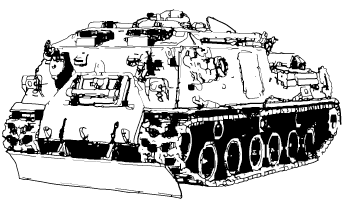- 鐵幣
- 26461 元
- 文章
- 11533 篇
- 聲望
- 11136 枚
- 上次登入
- 19-10-17
- 精華
- 175
- 註冊時間
- 05-12-25
- UID
- 215856
  
|
M88電腦繪圖

M88A1E1 Improved Recovery Vehicle
The M88A1E1 Improved Recovery Vehicle was intended to replace the M88, which is unable to tow the newer, heavier M1A1 tanks. System improvements consisted of an upgraded power pack (engine and transmission), higher winch and hoist capacities, increased tow/breaking performance, and increased armor protection. The Hercules includes additional weight (approximately 70 tons), an upgraded suspension, power-assisted brakes, and an improved hydraulic system. The Hercules will possess an auxiliary power unit to operate no-load recovery components and impact tools without running the engine. Additionally, the Hercules will be transportable worldwide by highway, rail, marine, and air in accordance with the Military Traffic Management Command Transportation Engineering Agency (MTMCTEA) transportability engineering analysis. The M88E1 was cancelled to provide funding for the new M109A6 howitzer, though development of the M88A1E1 restarted in 1991. The M88A1E1 IRV was type classified as the M88A2.
M88A2 HERCULES
The M88A2 HERCULES Hercules [Heavy Equipment Recovery Combat Utility Lift and Evacuation System], formerly the M88A1E1 Improved Recovery Vehicle, addresses a long-standing US Army need to upgrade its recovery vehicles to safely tow and recover battle-damaged, mired or inoperative Abrams tanks. The HERCULES, using M88A1 hulls, modified to specification by Anniston Army Depot, upgrades the basic M88 chassis to meet the increased demands of towing, winching, and lifting the M1, M1A1, and M1A2 tank.
Among the most significant upgrades is its on-board recovery systems. The winch and hoist capacities are greatly increased to enable the vehicle to lift 40% heavier loads and winch 55% higher capacities. HERCULES features a longer 35-ton hoist capability boom, a 140,000 pound (63,504 kg) constant pull main winch with 280 feet (85.3 m) of cable and an auxiliary 3-ton winch to aid main winch cable deployment. The Hercules also incorporates improved hydraulics, enhanced propulsion system, and heavier suspension, along with overlay armor protection and ballistic skirts. The vehicle's enhanced survivability with added armor which brings its weight to more of a match for the Abrams tanks it predominantly supports. The HERCULES upgraded power train which enables it to tow a 25% larger load, with better braking capacity and higher speeds to better enable it to accompany maneuver forces. The crew has been reduced from four to three soldiers. This action results from some of the on-board innovations such as an auxiliary winch to deploy the main winch, chain/davit hoists for heavy equipment/machinery and a grease operated track adjuster. |
|
